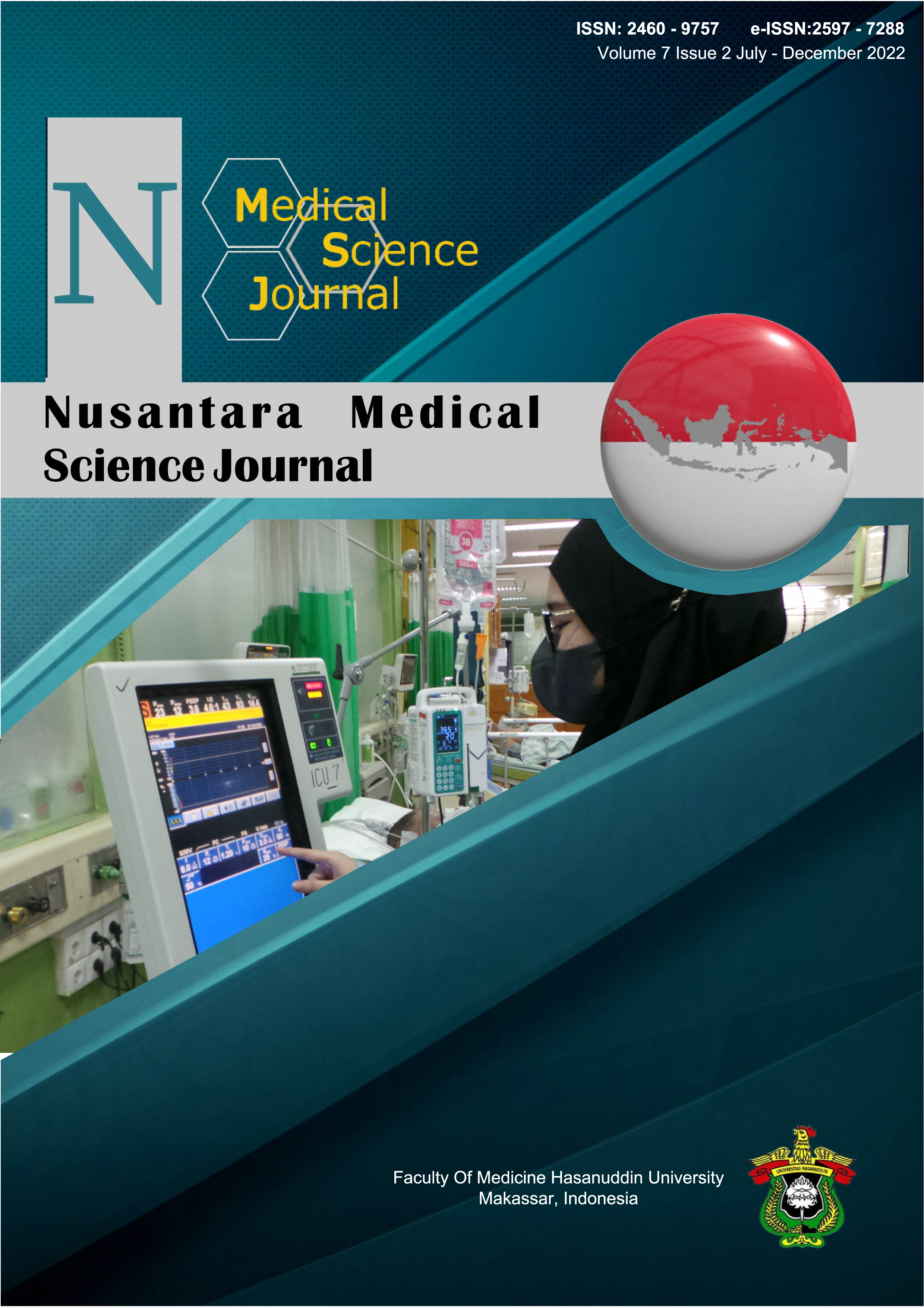The Turbidity, pH, Direct Gram as Predictors of Symptomatic Urinary Tract Infections in Pregnant Women
DOI:
https://doi.org/10.20956/nmsj.v7i2.20028Abstract
Introduction: Urinary tract infections (UTIs) are common in the community, including among pregnant women. This study investigates turbidity, urine pH, and direct gram as predictors of symptomatic urinary tract infection in pregnant women. Methods: A total of 177 pregnant women with suspected UTIs based on clinical and laboratories at the community health center in Makassar were collected from September to December 2021. The Urine sample was assessed for turbidity, urine pH, direct gram, and urine culture. Results: Urine turbidity was found in 108 (75.5%) patients who had positive cultures and PPV of 94.7%. The mean pH of the urine from UTI patients was 6.42 and without UTIs was 6.45. Urine that grows Gram-positive bacteria showed the most alkaline pH (mean pH=6.71) and was significantly less acidic than urine with UTI negative. In contrast, urine with Gram-negative bacteria had the most acidic pH (mean PH=6.30). The gram direct test shows a significant association with UTIs. Conclusions: Turbid urine can predict urinary tract infections in pregnant women that provide clinical symptoms. In addition, leukocytes esterase test further selected the samples. Urine pH showed no significant correlation with UTI. Less acidic urine pH is particularly associated with Gram-positive bacterial infections. Furthermore, direct gram can predict the event of UTI.
References
Stefaniuk EM. The usefulness of chromogenic media for qualitative and semi-quantitative diagnostic of urinary tract infections. Polish J Microbiol. 2018;67(2):213-218. doi:10.21307/pjm-2018-031
Subashchandrabose S, Mobley HLT. Virulence and fitness determinants of uropathogenic Escherichia coli. Microbiol Spectr. 2015;3(4):1-32. doi:10.1128/microbiolspec.UTI-0015-2012
Tan CW, Chlebicki MP. Urinary tract infections in adults. Singapore Med J. 2016;57(9):485-490. doi:10.11622/smedj.2016153
Glaser AP, Schaeffer AJ. Urinary tract infection and bacteriuria in pregnancy. Urol Clin North Am. 2015;42(4):547-560. doi:10.1016/j.ucl.2015.05.004
Matuszkiewicz-Rowińska J, Małyszko J, Wieliczko M. Urinary tract infections in pregnancy: old and new unresolved diagnostic and therapeutic problems. Arch Med Sci. 2015;11(1):67-77. doi:10.5114/aoms.2013.39202
Malau UN, Adipireno P. Uji korelasi leukosit esterase dan nitrit dengan kultur urin pada infeksi saluran kemih. Intisari Sains Medis. 2019;10(1):184-187. doi:10.1556/ism.v10i1.343
Strasing SK, Di Lorenzo MS. Urinalysis and Body Fluids, 5th Edition. Philadelphia: F. A. Davis Company; 2008. doi:10.1309/LMZE9PXB0A1OJLHD
Bulloch B, Bausher JC, Pomerantz WJ, Connors JM, Mahabee-Gittens M, Dowd MD. Can urine clarity exclude the diagnosis of urinary tract infection? Pediatrics. 2000;106(5):1-6. doi:10.1542/peds.106.5.e60
Foley A, French L. Urine clarity inaccurate to rule out urinary tract infection in women. J Am Board Fam Med. 2011;24(4):474-475. doi:10.3122/jabfm.2011.04.100007
Kumar M, Hembram B, Sharma AK, Prasad A. Gram staining as a predictor of urinary tract infection. J Dent Med Sci. 2018;17(12):1-4. doi:10.9790/0853-1712100104
Sartika IN, Suarta K, Ardhani P. Diagnostic value of urine gram staining for urinary tract infection in children. Paediatr Indones. 2009;49(4):205-208. doi:10.14238/pi49.4.2009.205-8
Wilson ML, Gaido L. Laboratory diagnosis of urinary tract infections in adult patients. Clin Infect Dis. 2004;12(6):1150-1158. doi:10.1097/01.idc.0000144910.19687.1f
Winquist AG, Orrico MA, Peterson LR. Evaluation of the cytocentrifuge gram stain as a screening test for bacteriuria in specimens from specific patient populations. Am J Clin Pathol. 1997;108(5):515-524. doi:10.1093/ajcp/108.5.515
Lai HC, Chang SN, Lin HC, et al. Association between urine pH and common uropathogens in children with urinary tract infections. J Microbiol Immunol Infect. 2021;54(2):290-298. doi:10.1016/j.jmii.2019.08.002
Rosana Y, Ocviyanti D, Halim M, et al. Urinary tract infections among indonesian pregnant women and its susceptibility pattern. Infect Dis Obstet Gynecol. 2020;2020:1-7. doi:10.1155/2020/9681632
Griffith DP. Struvite stones. Kidney Int. 1978;13(5):372-382. doi:10.1038/ki.1978.55
Marien T, Miller NL. Treatment of the infected stone. Urol Clin North Am. 2015;42(4):459-472. doi:10.1016/j.ucl.2015.05.009
Kline KA, Lewis AL. Gram-positive uropathogens, polymicrobial urinary tract infection, and the emerging microbiota of the urinary tract. Microbiol Spectr. 2016;4(2):459-502. doi:10.1128/microbiolspec.UTI-0012-2012
Remer T, Manz F. Potential renal acid load of foods and its influence on urine pH. J Am Diet Assoc. 1995;95(7):791-797. doi:10.1016/S0002-8223(95)00219-7
Fenton TR, Lyon AW. Milk and acid-base balance: Proposed hypothesis versus scientific evidence. J Am Coll Nutr. 2011;30(5):471S-475S. doi:10.1080/07315724.2011.10719992
Downloads
Published
How to Cite
Issue
Section
License
Copyright (c) 2022 Nusantara Medical Science Journal

This work is licensed under a Creative Commons Attribution 4.0 International License.









